Companies spend an average of $4,100 per employee on onboarding, per a study by SHRM, yet only 12% of employees think their organization + Read More
It’s live! Access exclusive 2025 live chat benchmarks & see how your team stacks up.
Get the dataIt’s live! Access exclusive 2025 live chat benchmarks & see how your team stacks up.
Get the data
Social media is a modern day holy grail for businesses: should your company achieve a successful social media strategy, the promise is happiness (for you and your customers), abundance (of engagement and incoming cash flow), and longevity (of your corporation… social media is, after all, a major driver of what keeps businesses relevant nowadays).
Although social media isn’t quite as mythicized as it was in its youth, companies that haven’t already done so are flocking to sign up for this golden communication and marketing opportunity. As of last year, at least 86% of Fortune 500 companies have an active Twitter account, and more than 50 million small businesses use Facebook to connect with consumers.
As true as the legends may be (yes, social media can win you fans and boost customer loyalty), social media customer service isn’t always sunshine and rainbows. Unfortunately for business owners, the path to social media success is riddled with potential disaster. If your company is to succeed – and thrive – on social media, there are a lot of social media mistakes that you need to avoid.
Today, Instagram is 7 years old. Twitter is 11 years old. Facebook is 13 years old, and LinkedIn is almost 15 (not to mention the sites that came before these, like Myspace and blogs that started as early as the late 90’s). The point is that businesses have been a part of the dialogue for long enough that nowadays we have a pretty clear idea of what to avoid in social media.
This blog post is a compilation of the worst social media customer service and marketing practices, that every successful business needs to avoid. We’ve included some real-life examples of companies that have already made these mistakes, so that you don’t have to.
Here is the list of the 15 mistakes to avoid:
I know, we’re starting out with something that doesn’t seem too dramatic. This social media mistake isn’t as obvious of a faux pas as some of our next bad customer service examples. However, it is worth mentioning because (A) it is all too rampant in social media customer service and (B) it is a complete nuisance.
Companies on social media often use their accounts primarily for marketing purposes, without understanding that a good marketing strategy also includes a quality customer service approach. This sort of strategy leads to a single department running the social media show, which means that social media agents aren’t empowered or even knowledgeable enough to help customers with their issues online.
The result is companies asking customers to switch channels and reach out instead by phone, email, or even by switching from one social media platform (such as Facebook) to the another (such as Twitter). This clogs customer service channels, wastes customers’ and agents’ time, and is frustrating for everyone involved.
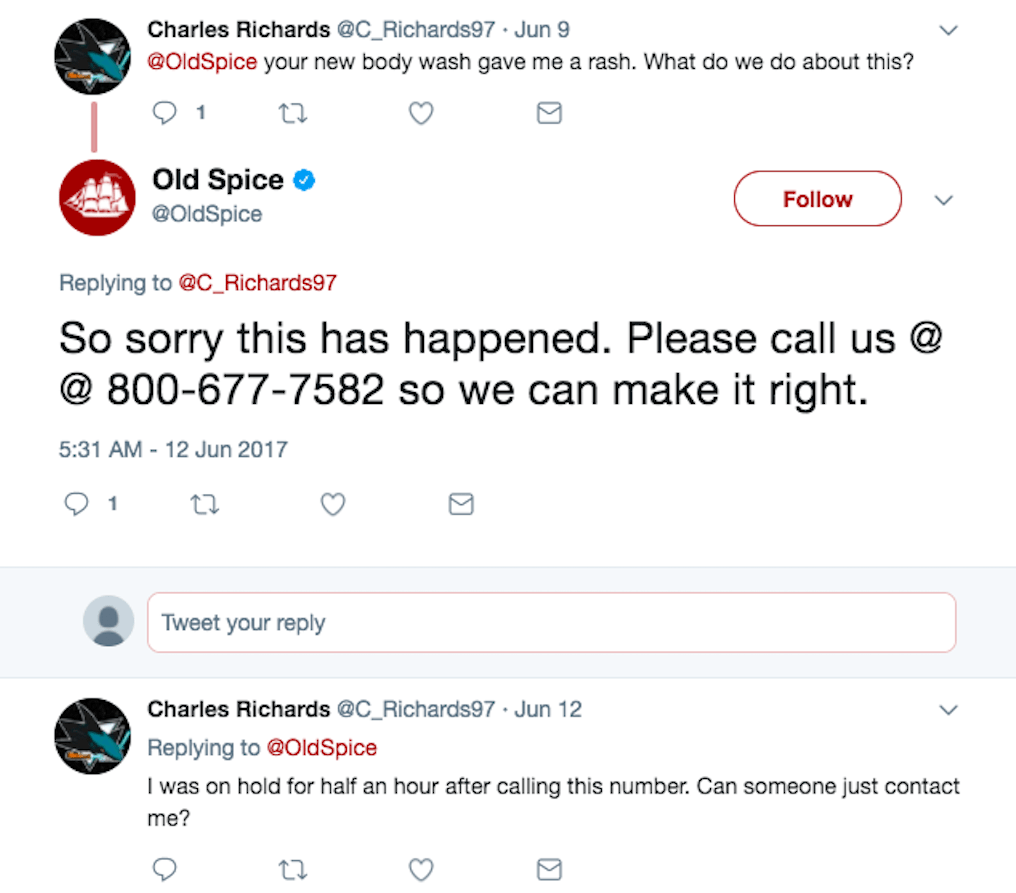
Takeaway: Channel switching is terrible and should be avoided.
Empower your agents to troubleshoot online, and to meet your customers where they are. Should you have to switch channels to take care of sensitive information, DM your customer and ask them for their phone number and what time they can be reached. Schedule the call according to what works for them – don’t deflect towards customer service (there’s a reason your customer reached out via social media instead of calling in the first place!).
While acceptable in some situations (such as if you have multiple Twitter accounts to serve customers in different countries), siloing social media accounts limits the range of interactions between your company and customers. When you have different social media accounts for different departments, you force customers to learn company hierarchies when all they really want to do is have their issue solved. This can be very confusing and even discouraging to customers who are looking for help.
Having different social media accounts for different operations reflects the organization’s needs, not the customer’s. It also poses the problem of greater resources being provided to specific care accounts than to the overall corporate Twitter accounts.
If you want to catch a glimpse of just how inefficient siloing social media accounts is, take a look at American Express’ Twitter, where response after response is dedicated to connecting users with a different account, @AskAmex, since their main account isn’t able to help the customers then and there.
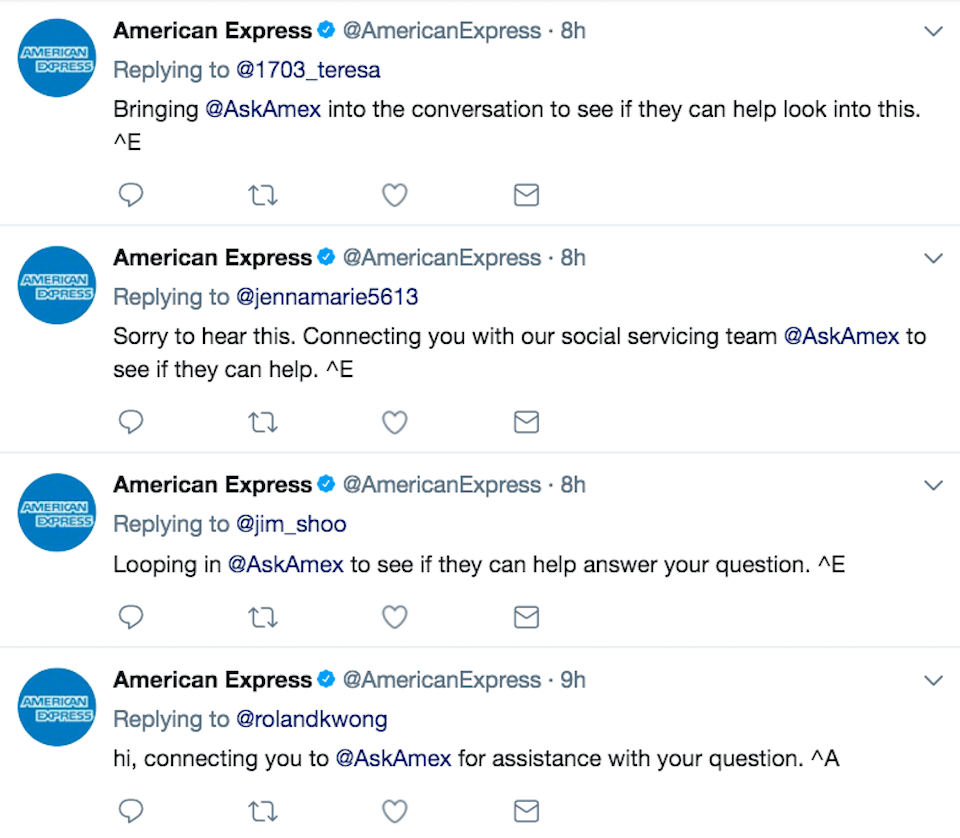
Takeaway: Only use two social media accounts on the same channel if they are both going to have an equal level of customer service, and both be helpful. Don’t ask the customer to contact your support Twitter if they reach out to your company’s general Twitter – that’s inconvenient to the customer and a waste of time for your teams.
Have one social media account per social media platform with shared ownership. That way customers won’t get lost in a sea of support options, and will know where to come for whatever they need – customer support, sales information, or otherwise.
Two things that don’t do well together are corporate social media use and censorship. Censoring followers could escalate an otherwise small issue, and cause customers to accuse your brand of not wanting to hear negative comments.
Worse, as several recent lawsuits have shown, this social media mistake could even result in legal repercussions – that is, if you are a U.S. politician.
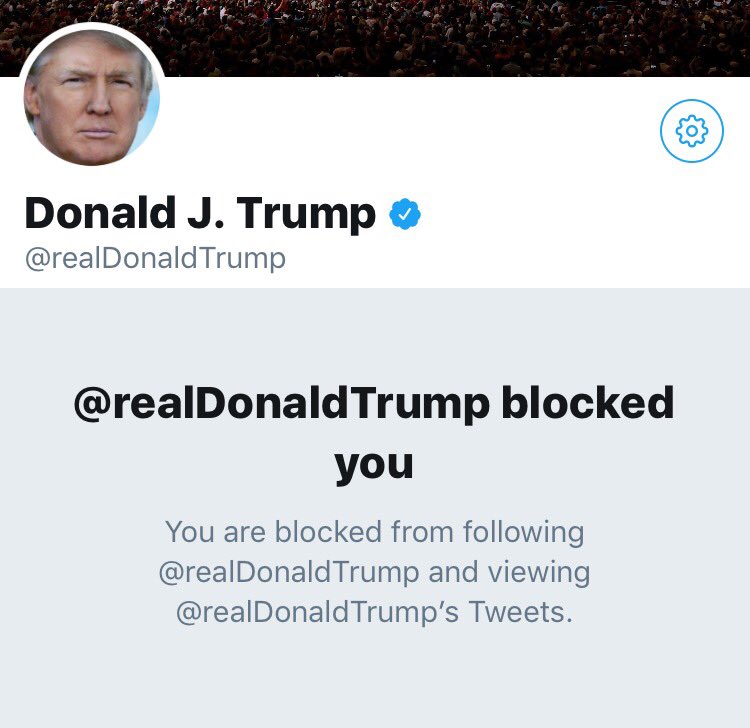
Politicians are, in many ways, their own brand. Because their social media pages are considered a public forum (and in Donald Trump’s case, tweets are ‘official’ White House statements) followers whose opinions have been censored via blocking or erasure have decried the act a violation of the freedom of speech, and have not gone out without a fight.
Blocking negative feedback is also a way of showing your customers that you can’t take the heat. One example of this is when Hardee’s blocked Wendy’s for a snide comeback that Wendy’s made to the competitor fast food chain.
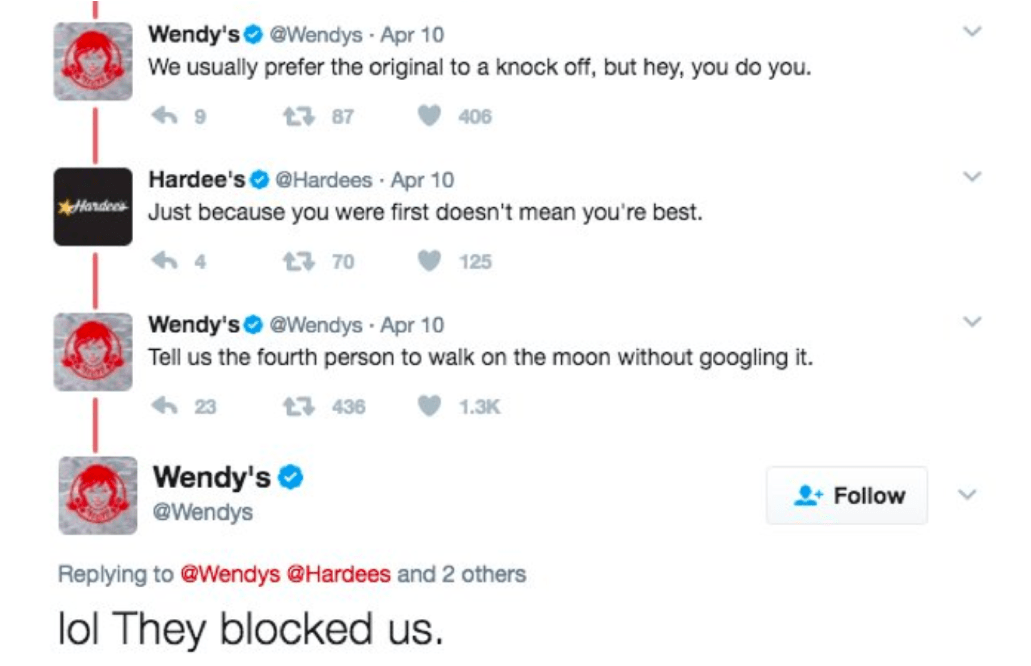
The internet was quick to praise Wendy’s, and Hardee’s use of censorship sealed its fate as the chain that just couldn’t keep up.
Takeaway: : There’s always going to be a customer who disagrees with you, or who maybe even offends you. Keep cool in these situations, and avoid censorship when possible.
Create a social media policy that clearly states the rules for engaging on your page. Save deletions for use as a last resort, when that policy is violated and harmful users need to be banned. If you use this policy – put the customer’s needs, not your ego first, and ban users that are spreading content that could be offensive or hurtful to your customers (obscene or discriminatory comments, threats against individuals, abusive language, etc).
It’s no secret that placing people behind a screen can encourage their inner trolls to come out. As clinical psychiatrist Alan Manevitz, M.D., puts it, “There’s a freedom of speech without a fear of consequences…There’s no inhibition. It’s like being drunk.” It’s so easy for things to deteriorate when a customer insults you. Take the following infamous bad customer service example, where the head chef of Boston-based restaurant, Pigalle, started up a nasty Facebook feud with a customer over an unsavory review:
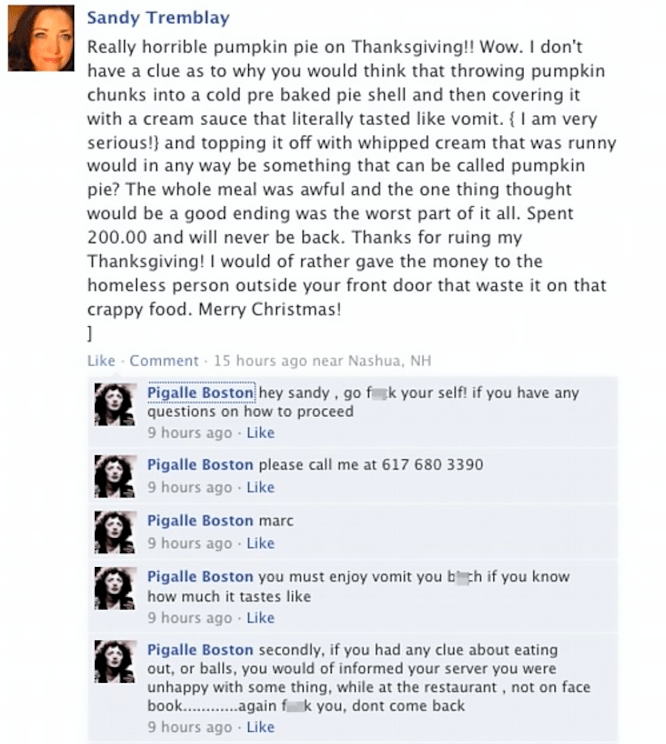
This kind of social media nightmare is liable to motivate customers to unfollow you—and never do business with you again.
Takeaway: Your ego isn’t worth insulting and alienating your customers
Before you respond to a negative comment, take a deep breath. Is what you are saying professional? Does it help the customer? Or are you just trying to take a jab at them?
Social media users don’t want brands to chime into every conversation. While it’s great to engage with customers who are explicitly looking for engagement (or who are tagging you as a part of their conversation), many users think that social listening is creepy. In fact, 32% of consumers have no idea that brands are listening online.
Not sure when to engage? According to a consumer study, 64% of customers say companies should respond only if they’re being directly addressed. 58% feel that companies should only respond to complaints. 48% say companies should listen only to improve products and services. 42% expect companies to respond to positive comments (these individuals want companies to join their conversation if they are saying nice things about them).
Takeaway: Sound contradictory? That’s because it is. Customers want companies to intuit when to respond and when not to.
When in doubt, speak when spoken to. Engage only when the context of the conversation allows for a smooth, natural, not-creepy engagement.
It isn’t hard to miss the mark when it comes to canned responses, especially if you aren’t reading all of what your customers wrote, or taking time to understand what they have to say.
One Twitter user pointed out how American Airlines messed up their canned messages by failing to do just that:

Whomever responded to this comment on behalf of American Airlines failed to read beyond the first line. As a result, they mistook the “Congrats” for genuine congratulations, and used a canned message that was not suited for the user’s sarcasm.
Takeaway: Canned messages can be helpful if they are used right, look bad if not.
Read what you are responding to fully before using a canned message. While quick responses are great, it’s more important that your responses be appropriate. Remember that it’s always better to get it right the first time than it is to have to go back and do damage control!
Over the summer, credit reporting agency, Equifax, discovered that hackers had gained access to sensitive information on more than 40% of Americans. In an attempt to remedy the situation, the company set up a separate website where potential victims could check to see if they had been affected by the breach: www.equifaxsecurity2017.com.
One programmer noticed that this site had some obvious vulnerabilities, and created a fake site to highlight those problems. He called this site securityequifax2017.com. The fake site looked exactly like the old one, except that the headline read: “Cybersecurity Incident & Important Consumer Information Which is Totally Fake, Why Did Equifax Use a Domain That’s So Easily Impersonated by Phishing Sites?”
Equifax’s social media team also fell for the fake site, tweeting the wrong link at least four times to breach victims who were asking for assistance.
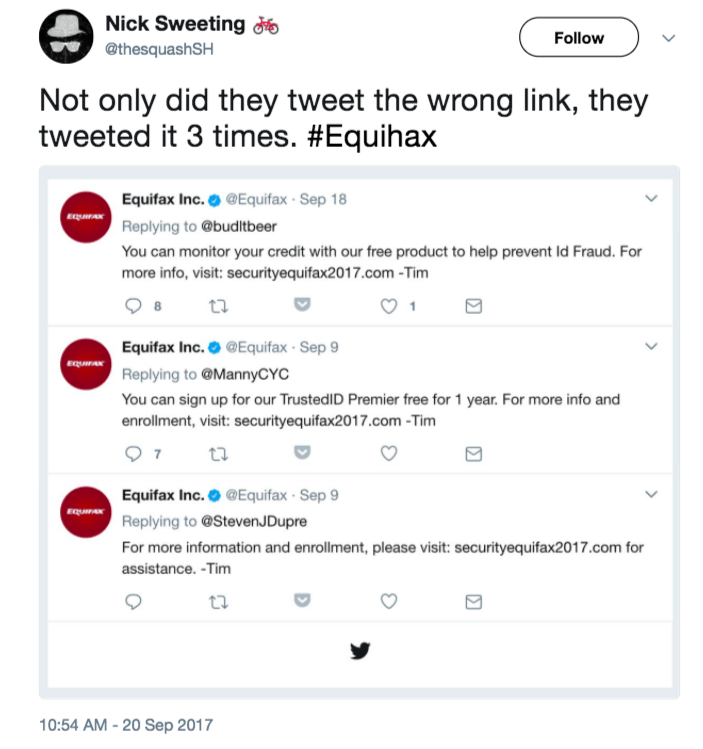
Takeaway: If you’re going to tweet information to your customers, make sure that it’s the right information.
Double check company information you send out. Don’t forget to check for website misspellings.
Uneducated posts can hurt a company’s reputation, and cause a backlash on social media. This is in part due to how easy it is for these types of slip-ups to go viral. Take for example, this post that Delta made during a world cup match between Ghana and the US:

The problem with this tweet: there are no giraffes in Ghana. Twitter was quick to educate Delta, and generated a huge amount of bad press for the brand. As one news source put it: “Delta Airlines is flying blind when it comes to geography.”
Another example of an ignorant social media post is the time that American Apparel mistook a picture of the Space Shuttle Challenger exploding for fireworks.

The image, which was hashtagged with #smoke and #clouds, was posted to the company’s Tumblr, and was supposed to be an Independence Day post. This post, like Delta’s, caused a substantial social media backlash, and showed the value of doing your homework before posting.
Takeaway: Ignorance on social media isn’t bliss.
If you aren’t sure about something, research it before you post! Even if you think that you know something, it doesn’t hurt to look it up anyway. When it comes to social media marketing, Google is your friend.
Pigalle showed us that you should never write comments that insult your customers. It’s just as important to not insult your customers with the content of your social media posts. This means not running any social media marketing campaigns that could offend or alienate a large group of customers.
Unfortunately, there are numerous examples of insensitive social media marketing campaigns. Back in 2013 Home Depot apologized after posting a tweet that featured two African American men drumming with a monkey.
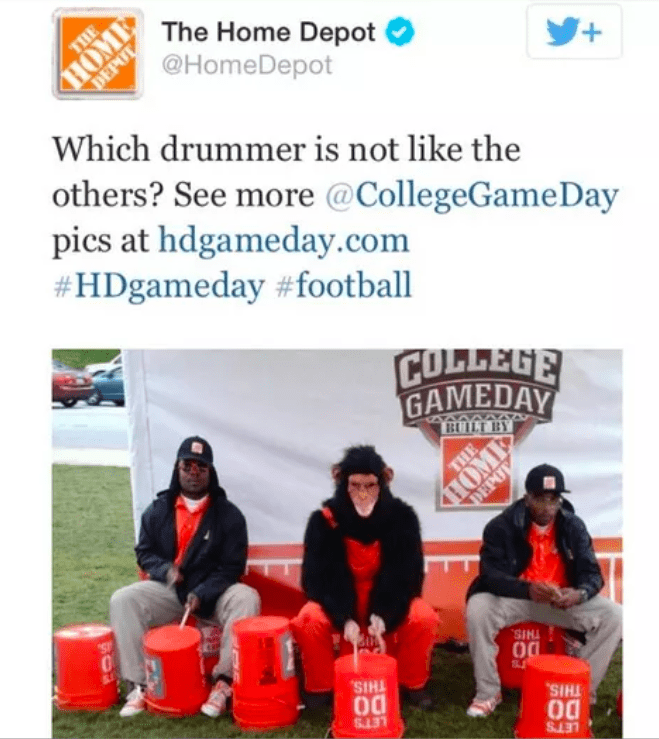
The tweet was deleted promptly, but that didn’t stop it from circulating and upsetting hundreds (if not thousands) of people.
In another, more recent example, Nivea posted a tone-deaf deodorant ad to its Middle Eastern Facebook page. The ad, which used the slogan “white is purity,” was removed after 48 hours.
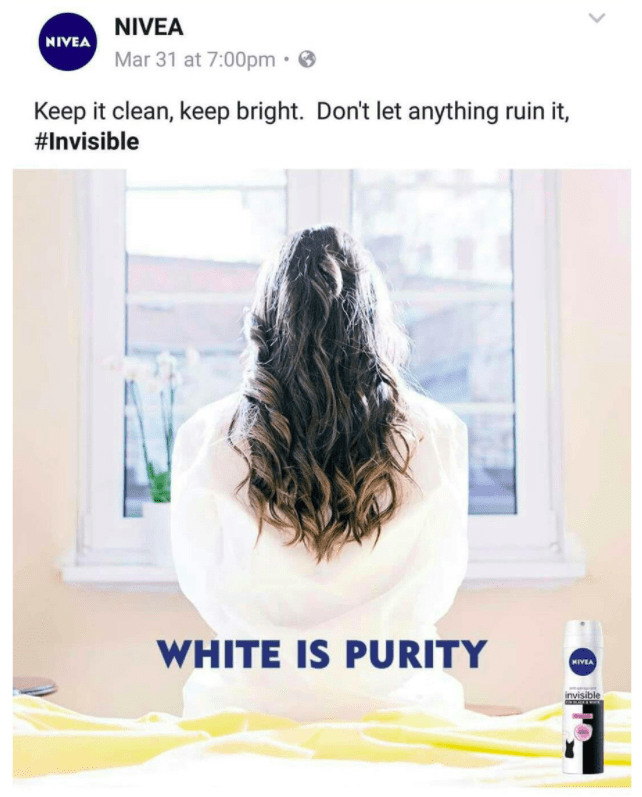
In the time that it spent online, it was slammed for racism, and embraced by white supremacists, who began sharing it on social media. The CEO later apologized.
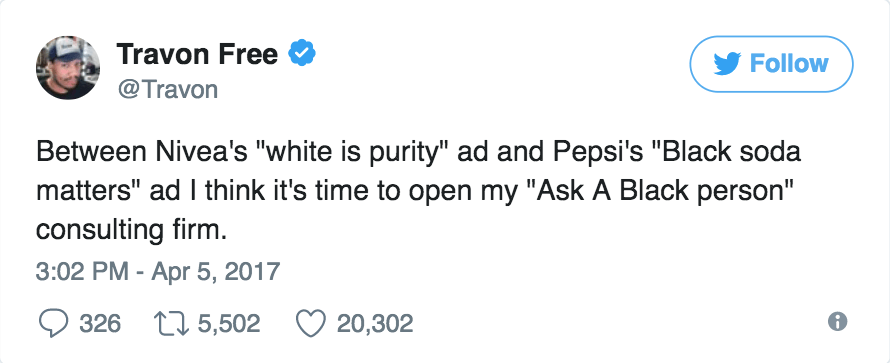
Takeaway: Gone are the days when companies could get away with Tone-Deaf and insensitive marketing. Your brand needs to create non-offensive content that empowers, rather than hurts, your audience.
Social media rightfully holds companies accountable for offensive advertisement. Before approving a social media marketing scheme, make sure that your marketing plan does not alienate anyone of a certain race, gender, sexuality, religion, country, etc. And if you aren’t sure, ask someone who would know!
Brands like to be in on what’s trending now, and using hashtags is a great way to do that. However, engaging with the wrong hashtag is another way to generate insensitive content that upsets customers.
One example of this is when DiGiorno accidentally made light of domestic violence by misusing the #WhyIStayed hashtag.
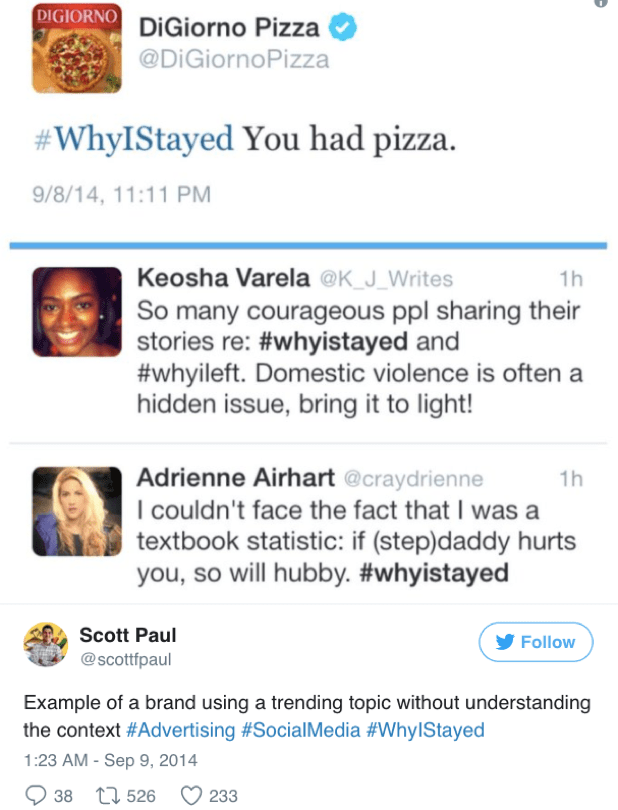
Following the incident, DiGiorno apologized one by one to each tweet that came their way (this was a great time to ditch the canned message and provide quality, customized customer care).
Takeaway: Be careful what you hashtag.
Before using a trending hashtag, take a look at what it’s referencing. That will help you make sure you don’t jump on any bandwagons you don’t want to be on! Another tip is to start your own conversations, and develop your own hashtags to get customers talking.
Social media can be a great place for making corporate apologies. However, it’s a terrible place for making bad apologies.
After the United Airlines incident when a passenger was dragged bloodied off of a plane, United dug the hole deeper by issuing a poor apology to social media.
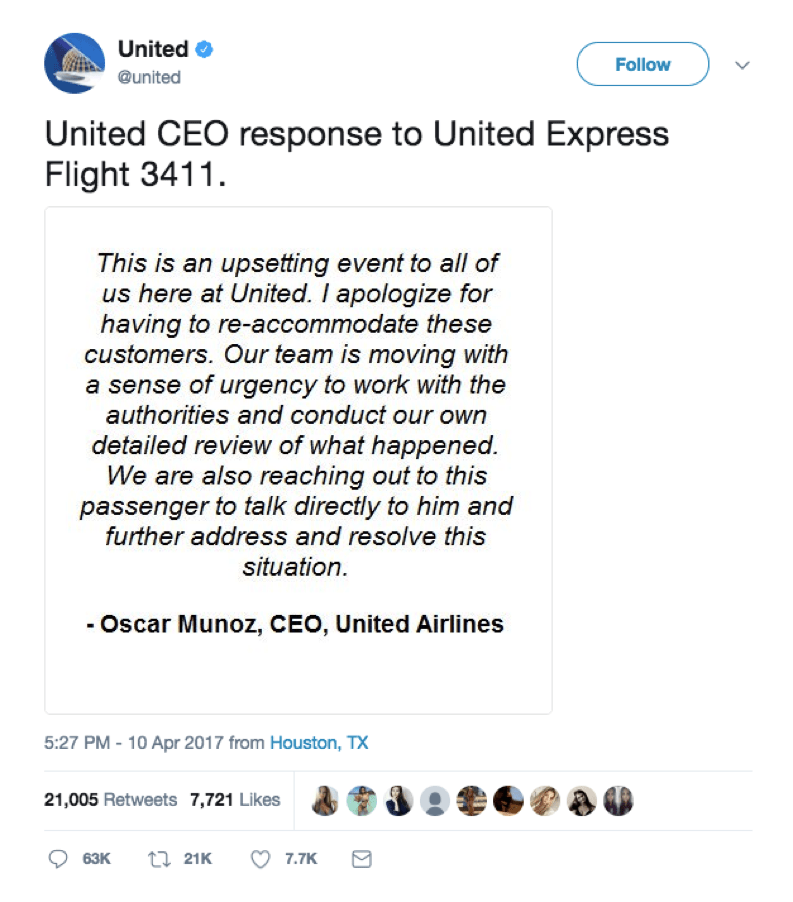
United’s apology was deemed victim blaming (it shifted blame away from the organization and insinuated that the passenger may have been at fault), and sparked outrage amongst social media users.
Takeaway: If you’re going to use social media to make a public apology – and you should if it is ever necessary – make it a good one.
Show regret and apologize. Never blame others, and deal with the problem instead. Make the apology as human and heartfelt as possible so that your customers and audience will know that you mean it.
Accidentally posting a personal status on the corporate account is an extremely common Twitter mistake, and is one that varies from harmless to less forgivable depending on the content of the personal post.
One of the most famous examples of someone posting in the wrong Twitter account is when an employee accidentally tweeted her plans for the night from the American Red Cross’s Twitter.
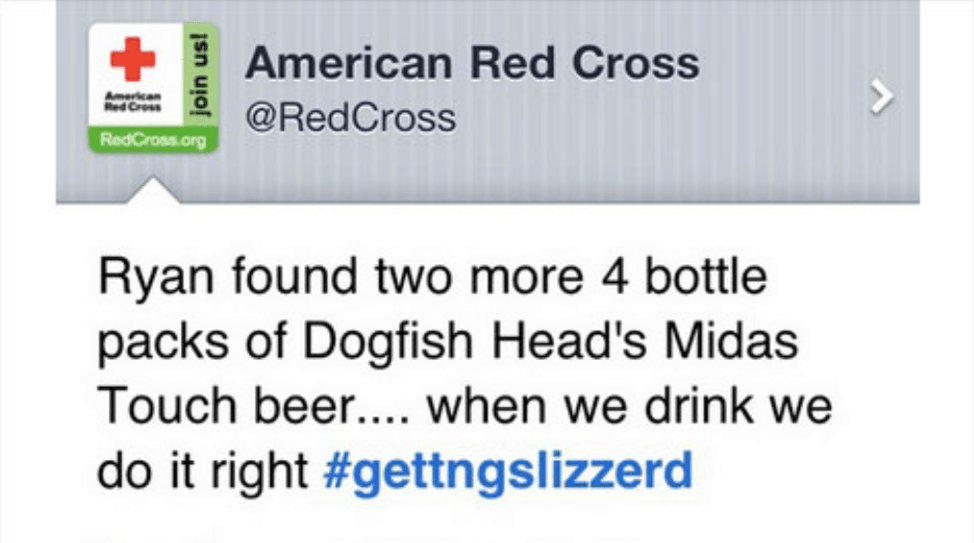
Luckily the Red Cross engaged in a great social media recovery, and made light of the misplaced tweet with a funny post.
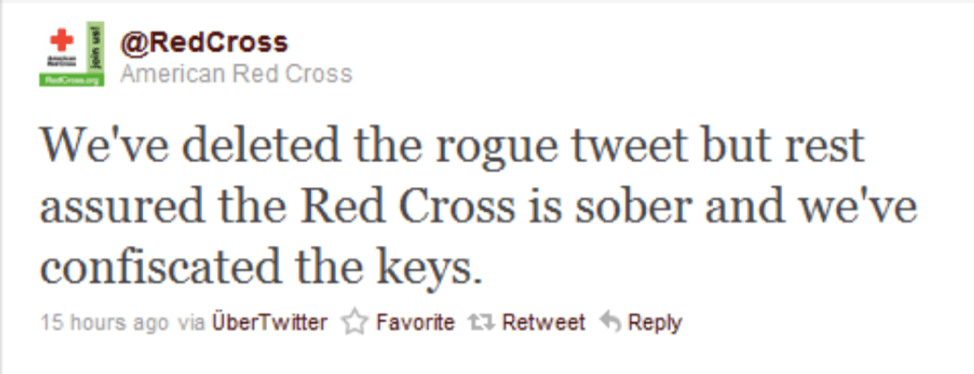
Takeaway: Those of us with access to a corporate social media account need to take care to make sure we aren’t posting in the wrong account. This includes taking steps towards prevention, and having plan for handling this issue once it happens (such as a designated response team).
Use different browsers for different accounts (for example, Firefox for your corporate account and Safari for your personal account). That way you are less likely to post in the wrong account by mistake. Should you need to access your corporate social media account on the go from a mobile device, you can also use different aps for different accounts, (for example, try using the Twitter ap for your corporate account, and open Twitter in your phone browser for your personal account). Log out of the corporate social media account when you are done posting to further avoid posting from the wrong account.
Maybe you’ve heard of Old Man Tweets, a Twitter account that is supposedly an 81-year-old man who thinks that Twitter is a search engine, and makes public posts that are supposed to be private Google searches.
While companies and business owners most likely won’t make the same mistake as Norman N. (aka the old man), Twitter’s CFO proved that we still have to take care to not accidentally post a private DM on our public feed.
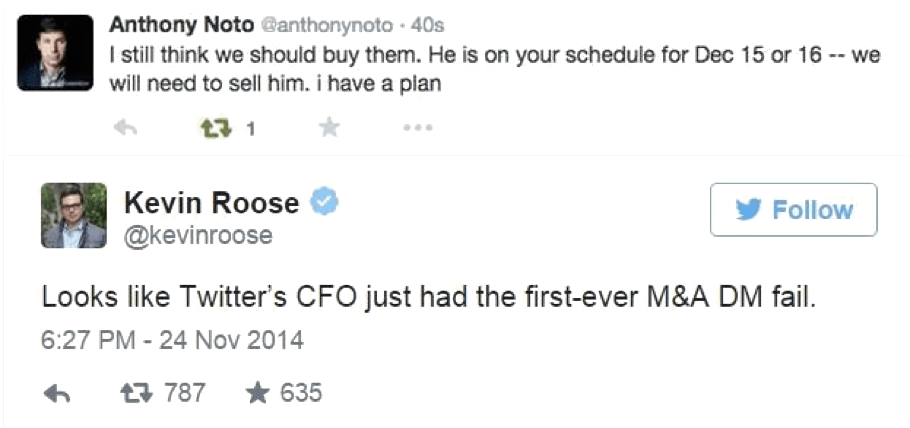
Takeaway: The good news is that this hilariously cryptic tweet could have been a lot worse.
Double check what box you’re typing in before you hit “Send”
It might seem harmless to automate a congratulatory Tweet to your 1 millionth follower. Like canned messages, automated messages can save you time and can also be used to mark special metrics that you would otherwise have missed.
However, it wasn’t so harmless for the New England Patriots. The New England Patriots’ automatically thanked a user with a racist name, retweeting the offensive Twitter handle in the process.
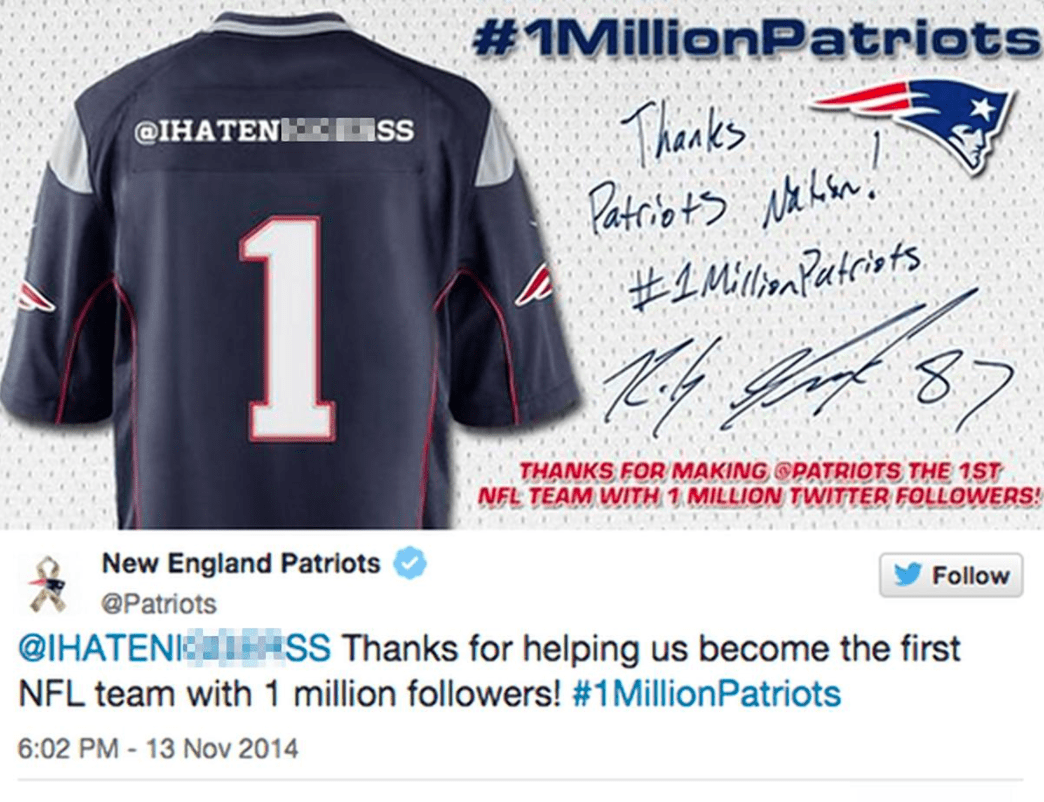
If you need any more evidence that automating social media posts is something to be wary of, look no further than Microsoft’s bot, TayTweets, who turned into a pro-Hitler troll after just 24 hours online.
Takeaway: Don’t trust bots for reliable, non-offensive social media posts.
Submit all automated tweets for approval before sending out. Strengthen Filters for automated tweets, so that you don’t send any offensive content to your audience.
Trolls and hackers are a natural part of the social media landscape. Don’t forget to pay attention to your social media page, so that you can delete any imposter posts.
One famous rogue social media post from this year was when McDonalds got political.
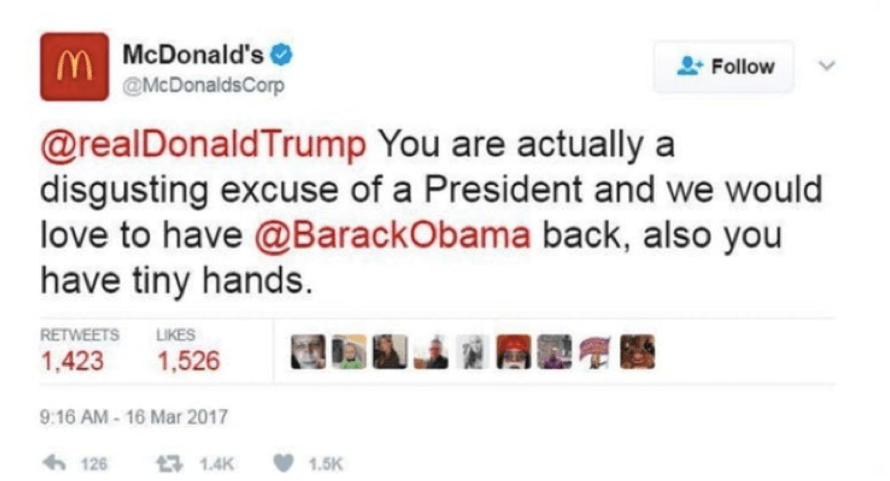
The tweet was up for a total of 20 minutes before McDonalds took it down, citing an external hack. It was still long enough for the post to go viral, causing mixed reactions and prompting some users to start a new hashtag, #BoycottMcDonalds.
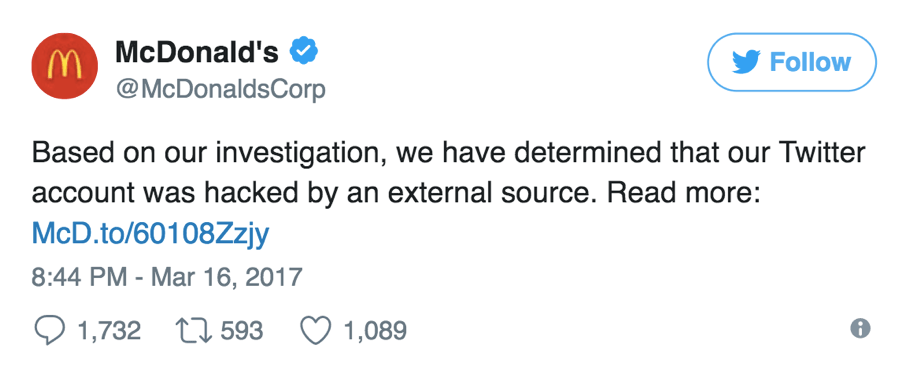
Another example of online trolling that you need to watch out for are trolls in the comment section of sites such as Facebook. One user created a fake Facebook account and responded to customers before Target’s own social media team could, pretending to represent the company.
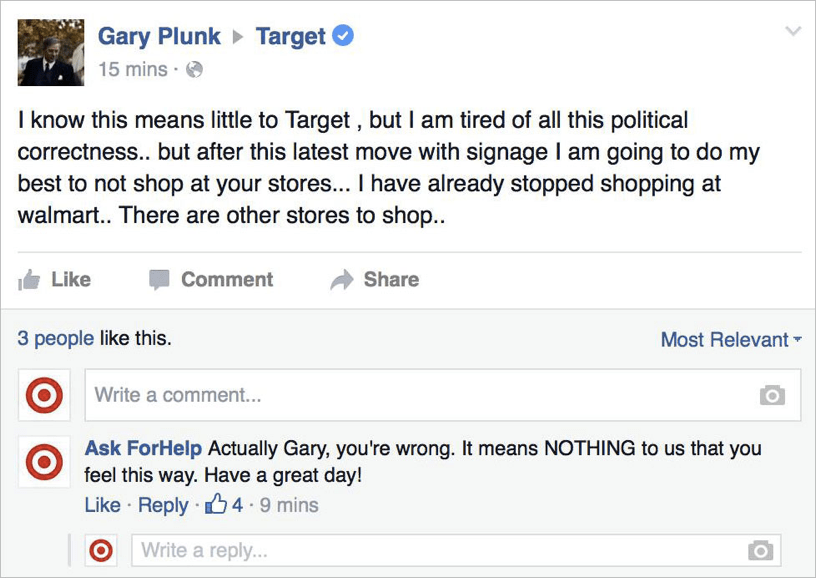
And lastly, sometimes the threat is internal, rather than external. HMV went viral after upset employees briefly took over the company’s Twitter during layoffs and began live tweeting as they were being fired.
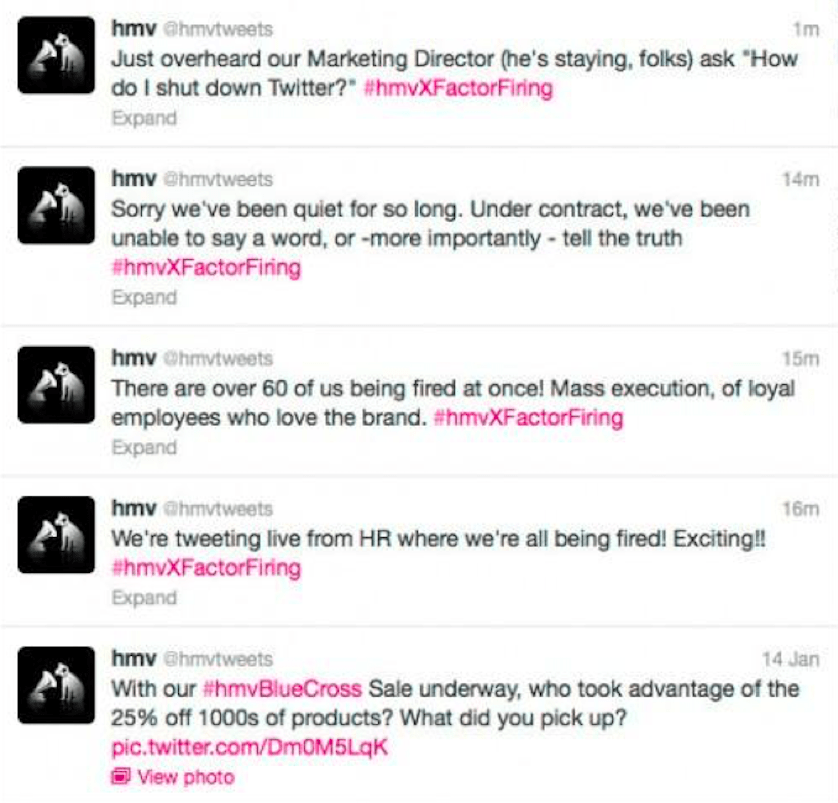
Takeaway: Stay vigilant for any unapproved activity on your social media platforms.
In the event of an external hack, make sure that you change your passwords and investigate the origin of the hack, and the security of your system. Make sure that someone in management has access to your social media page, and that all password and login information are securely stored. Use management’s information when adding recovery emails and security questions to social media accounts.
All the mistakes that other companies have made on social media have something in common: they can help you learn what to avoid on social media. By using these worst practices as a list of “Do not’s,” you can guide your social media team towards what works and away from what doesn’t.
And, if one day you or your team makes one of these social media mistakes, don’t worry – mess-ups happen! The important part is catching them quickly, and taking the proper steps to prevent any social media mistakes from happening again.